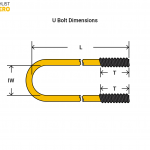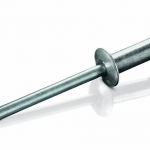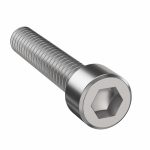Aluminum provides a lightweight, yet strong option for material construction vs alloys, which have a broader range of physical characteristics. Both are excellent materials used in a variety of engineering applications. In this article, we review the properties of aluminum, general alloy, and aluminum alloy, as well as compare aluminum vs alloys.
Aluminum Properties
Aluminum is a predominant non-ferrous metal on Earth with an application in a wide variety of projects due to its properties. Its combination of strength and lightweight makes it ideal for manufacturing aircraft and automobile components.
Unlike steel, aluminum has excellent corrosion resistance and does not require additional treatment such as painting. Thus, making it a good material for outdoor applications such as railing, roofing sheets, and window frames. In addition, aluminum is a good option when producing cans for long-term storage of food and beverages. In terms of workability, it is very easy to handle using traditional tools, so it can form a variety of shapes to meet the demands of an application. Aluminum is also environmentally friendly as it is easy to recycle, unlike an alloy.

General Alloy Properties
Generally, an alloy offers superior mechanical properties to pure metals including aluminum. This is because it combines the desirable properties of other elements into a metal by adding them in small quantities into the metal’s microstructure. Most alloys are iron-based, with small percentages of other elements including carbon, molybdenum, nickel, silicon, and manganese.
The presence of these elements makes the alloy steel able to withstand temperatures up to 2012 °F without breaking down or becoming brittle. As a result, alloys are ideal for high-temperature, high-pressure applications, as well as for making parts that undergo extreme loading. However, in comparison to aluminum, alloy steel is more difficult to work with due to its higher levels of hardness and strength. Also, it is a more expensive material.
Aluminum Alloy Properties
Aluminum alloy is an excellent alternative to steel alloy when providing lesser strength and hardness levels. It is the second most common alloy that incorporates the elements such as copper, zinc, silicon, manganese, and magnesium. The resulting material delivers better strength than pure aluminum, without compromising on its lightweight and corrosion resistance. Generally, it is convenient to divide aluminum alloys into two categories namely:
- Wrought alloys: This design delivers alloys that are fracture-resistant and highly ductile to suit applications where there may be plastic manipulation. For example, automotive parts, aircraft, electrical wiring, and sports equipment. For wrought alloys, International Alloy Designation System uses a four-digit number to represent each alloy. The first digit indicates the major alloying element. If the second digit is different from zero, then it indicates a variation of the alloy. While the third and fourth digits identify the specific alloy in the series.
- Cast alloys: Because the production of these alloys involves casting, the material needs to combine attractive physical characteristics as a solid with a low coefficient of expansion and low melting points. Some applications of these alloys are machine tool parts, truck chassis, and marine castings. The description of cast alloys uses a three-digit system, with a decimal value following. Like the wrought alloy nomenclature system, the first value indicates the major alloy. While the second and third digits show the minimum percentage of aluminum. For example, 295.0 corresponds to a minimum of 99.95% aluminum. As for the digit after the decimal point, it takes a value of zero for a casting, while values of one and two indicate an ingot. Whereas a capital letter prefix shows a modification to the alloy.
General Alloy vs Aluminum
The following table highlights the differences between a general/steel alloy and pure aluminum.
| Steel Alloy | Aluminum |
| It is an iron-based metal with the addition of elements such as silicon, chromium, and manganese. | Constitutes a single element that is derived from bauxite ore. |
| Delivers better strength and hardness, so it is ideal for high-temperature, high-pressure, and extreme-loading applications. | Aluminum is useful in construction but requires the addition of elements to operate under significant loads. |
| Steel alloy is corrosion-resistant, but not as good as aluminum. | Excellent corrosion resistance making it ideal for storing food and beverages. |
| Heavy with a generally dull appearance with the exemption of stainless steel. | Lightweight with a glossy appearance which adds to the aesthetic value of the parts. |
Aluminum Alloy vs Aluminum
| Aluminum Alloy | Aluminum |
| Although aluminum is the base metal, it constitutes other elements including zinc, copper, and silicon. | Aluminum is a single-element metal. |
| Possesses higher strength and ability to withstand extreme loading, and work environments of high pressure and temperature. | Not able to withstand significant loading as well as extreme temperature and pressure. |
| Serves in manufacturing parts for a wide variety of applications. | Because it is soft, it is limited in use to foils and cans for food and beverage storage. |
| Aluminum alloy is more corrosion-resistant than pure aluminum. | Good corrosion resistance but not as much as its alloy. |
| More difficult to recycle and more expensive. | Its products are environmentally friendly as they are easy to recycle. Also, they are less expensive. |
Aluminum Alloy vs Steel Alloy
Although they are both alloys, there are some differences between them as the following table highlights.
| Steel Alloy | Aluminum Alloy | |
| Strength | Generally stronger and unyielding, due to the presence of carbon in its microstructure. | Although it is weaker than steel, some aluminum alloys are stronger than steel. |
| Weight | The higher the carbon content, the heavier the alloy is. | Has no carbon content so it is lighter. |
| Corrosion | Has some level of corrosion resistance, but still oxidizes in damp or abrasive environments. As a result, often requires some treatment or painting to minimize rusting. | Possesses superior corrosion resistance, so does not require painting or any treatment. |
| Applications | Ideal for buildings, bridges, railways, pipelines, and other applications with high levels of loading, temperature, and pressure. | Excellent for where a combination of strength, lightweight, and aesthetics are important. Some include airplane parts, car parts, packaging, and utensils. |
| Cost | It is a cheaper metal than aluminum alloy. | Although global prices often fluctuate, it is usually more expensive than steel. |



